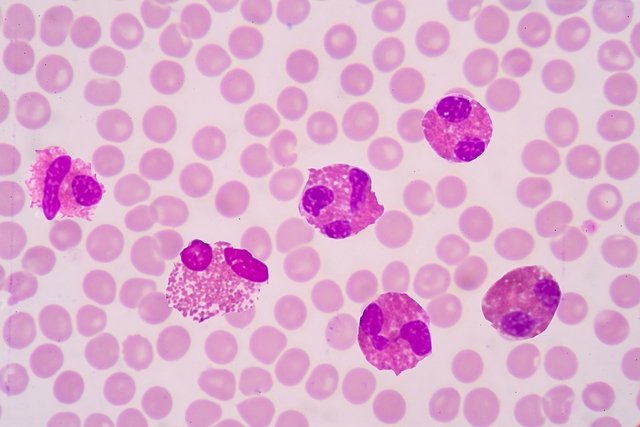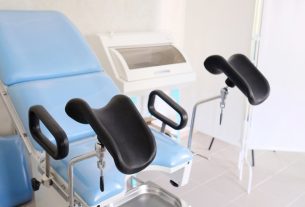Eosinophils are a type of blood defense cell that originates from the differentiation of a cell produced in the bone marrow, the myeloblast, and its objective is to defend the organism against the invasion of foreign microorganisms, being very important for the action of immune system.
These defense cells are present in the blood in high concentrations, especially during allergic reactions or in cases of parasitic, bacterial and fungal infections. On the other hand, its concentration may decrease in the acute phase of some bacterial infections, after surgery or as a consequence of the use of corticosteroids.
In relation to other defense cells, such as lymphocytes, monocytes or neutrophils, eosinophils circulate in lower concentrations in the body. Learn more about blood cells.

Reference values
The amount of eosinophils in the blood is assessed in the leukogram, which is a part of the blood count in which the body’s white cells are evaluated. Normal blood eosinophil values are:
- Absolute value: 20 to 500 cells/µL of blood – is the total count of eosinophils in the blood;
- Relative value: 1 to 6% – is the percentage of eosinophils in relation to other cells in the white blood cell count.
The values may change slightly depending on the laboratory in which the test was carried out and, therefore, the reference value must also be checked in the test report itself.
In the presence of altered values, it is important that the test result is evaluated by the doctor taking into account the other blood count results, as well as the results of other blood tests that may have been requested.
Do you have questions about your exam results?
If you have had a recent blood test and want to know if your eosinophil count is normal, please indicate your result:
High eosinophils
An increase in the number of eosinophils in the blood is known as eosinophilia and occurs when there are more than 500 eosinophils per µL of blood. The increase in the amount of these cells in the blood can happen due to some situations, the main ones being:
- Allergysuch as asthma, urticaria, allergic rhinitis, dermatitis, eczema;
- Worm parasitessuch as ascariasis, toxocariasis, hookworm, oxyuriasis, schistosomiasis, among others;
- Infectionssuch as typhoid fever, tuberculosis, aspergillosis, coccidioidomycosis, some viruses;
- Allergy to medication usesuch as AAS, antibiotics, antihypertensives or tryptophan, for example;
- Inflammatory skin diseasessuch as bullous pemphigus, dermatitis;
- Other inflammatory diseasessuch as inflammatory bowel disease, hematological diseases, cancer or genetic diseases that cause hereditary eosinophilia, for example.
In some rare cases, it is still possible to not discover the cause of the increase in eosinophils, a situation called idiopathic eosinophilia. There is also a situation called hypereosinophilia, which is when the eosinophil count is very high and exceeds 10,000 cells/µL, being more common in autoimmune and genetic diseases, such as hypereosinophilic syndrome.
Eosinophilia itself does not lead to the appearance of signs or symptoms, however it is possible that the person may present some symptoms as a result of the increase in the number of circulating eosinophils, which may lead to shortness of breath, sneezing, nasal congestion, itchy skin, fever , body pain, diarrhea or abdominal pain, for example.
Low eosinophils
A decrease in the amount of eosinophils in the blood is known as eosinopenia and occurs when eosinophils are below 20 eosinophils per µL of blood.
Eosinopenia can occur in the case of acute bacterial infections, such as pneumonia or meningitis, for example, as these are serious bacterial infections that tend to increase other types of defense cells, such as neutrophils, which can reduce the absolute or relative count of eosinophils. .
The reduction in eosinophils can also be the result of decreased immunity due to illnesses or the use of medications that alter the function of the immune system, such as corticosteroids.
Furthermore, eosinopenia can be a consequence of pernicious anemia, burns, Cushing’s syndrome, seizures or occur after surgery, for example.
Bibliography
- HINRICHSEN, Sylvia Lemos. Causes of… Differential diagnosis. 1 ed. Rio de Janeiro: Medbook, 2014. 293-295.

Sign up for our newsletter and stay up to date with exclusive news
that can transform your routine!
Warning: Undefined array key "title" in /home/storelat/public_html/wp-content/plugins/link-whisper-premium/templates/frontend/related-posts.php on line 12
Warning: Undefined array key "title_tag" in /home/storelat/public_html/wp-content/plugins/link-whisper-premium/templates/frontend/related-posts.php on line 13



